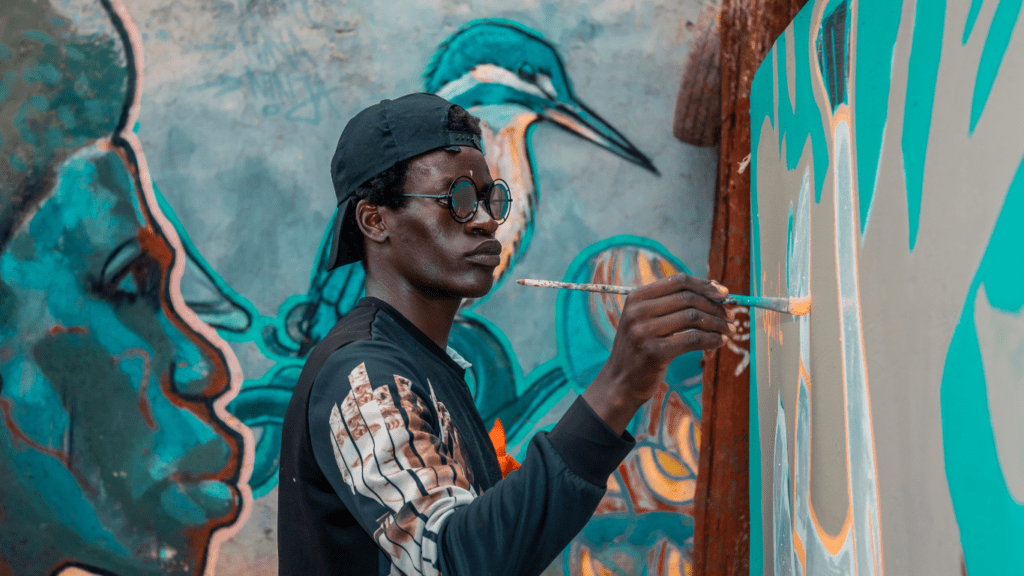Examining the Impact of War on Art Movements
War brings profound changes, deeply influencing art. These tumultuous periods often lead to shifts in artistic expression and themes.
Post-World War II Abstract Expressionism
Abstract Expressionism emerged in the United States during the late 1940s and 1950s. This movement reflected the chaotic aftermath of World War II. Artists like Jackson Pollock and Mark Rothko sought to capture raw emotion and existential angst.
Pollock’s drip paintings, for example, displayed a sense of chaos and energy. Rothko’s color fields explored deep human emotions. This movement marked a shift from European dominance in modern art to American leadership, highlighting a new cultural center.
Vietnam War and Pop Art
Pop Art gained prominence during the 1960s, in part as a response to the Vietnam War. This movement, characterized by imagery from mass culture, included artists like Andy Warhol and Roy Lichtenstein.
Warhol’s work often featured consumer goods and celebrities, reflecting the pervasive influence of media. Lichtenstein used comic strip styles to comment on contemporary issues.
Pop Art’s focus on popular culture enabled pointed critiques of the political climate and societal values during the Vietnam War era. The movement showed how art could incorporate and question everyday life amidst conflict.
Social Revolutions and Their Artistic Echoes
Art often traces the contours of social upheaval, reflecting the profound changes societies undergo during revolutions. Social revolutions leave unmistakable imprints on artistic expression, embodying the spirit of the times.
Harlem Renaissance in the 1920s
The Harlem Renaissance, emerging in the 1920s, marked a vibrant flowering of African American culture. Central figures like Langston Hughes, Zora Neale Hurston, and Aaron Douglas gave voice to the Black experience, blending elements of jazz, folklore, and modernism.
Literature, painting, and music from this period celebrated African American heritage, innovating with new forms and languages to challenge the prevailing racial prejudices.
Artists drew inspiration from African motifs, creating a unique fusion that revitalized American culture.
1960s Civil Rights Movement and Black Arts Movement
The 1960s Civil Rights Movement ignited the Black Arts Movement, leading to a profound cultural renaissance. This period saw artists like Amiri Baraka and Maya Angelou leveraging their platforms to champion social justice and racial equality.
Their works often featured powerful narratives and stark imagery to confront systemic oppression. Through:
- poetry
- theater
- visual art
- music
Creators provoked thought and encouraged activism.
The Black Arts Movement emphasized pride in African heritage, advocating for artistic autonomy and the establishment of a Black aesthetic.
Economic Changes and Artistic Transformation

Artists are often influenced by the economic climate, leading to dramatic shifts in style and subjects.
The Great Depression and American Regionalism
The Great Depression drastically shaped American Regionalism. As economic hardship spread, artists like Grant Wood and Thomas Hart Benton captured rural American scenes.
Their works reflected resilience, community spirit, and traditional values. People sought solace in familiar imagery, and Regionalism provided comfort during uncertain times. Wood’s “American Gothic” (1930) is a prime example of this movement’s focus on realism and local culture.
The Roaring Twenties and Art Deco
Art Deco emerged during the Roaring Twenties, a period of economic prosperity and cultural dynamism.
- Characterized by geometric shapes, bold colors, and lavish ornamentation, Art Deco symbolized modernity and luxury.
- Prominent figures like Tamara de Lempicka used this style to depict the era’s glamour.
- Buildings like the Chrysler Building in New York showcased Art Deco’s influence on architecture, highlighting the era’s fascination with innovation and opulence.
The economic boom enabled lavish designs and artistic experimentation, reflecting the decade’s exuberance.
Rise of Feminism and Changes in Artistic Representation
Feminism has profoundly impacted artistic representation. It has influenced both the themes explored in art and the forms it takes.
The Feminist Art Movement of the 1970s
The 1970s saw the rise of the Feminist Art Movement. Artists like Judy Chicago, Miriam Schapiro, and Faith Ringgold started challenging the male-dominated art world. They created works that highlighted women’s experiences and redefined traditional representations of women.
Judy Chicago’s “The Dinner Party” exemplifies this movement, presenting a triangular table with 39 place settings, each honoring an influential woman from history. This piece questioned why women’s achievements were often overlooked.
Miriam Schapiro and the Pattern and Decoration movement focused on incorporating traditionally “feminine” crafts like sewing and ceramics into fine art, challenging the hierarchy between “high” art and “craft.”
Faith Ringgold combined quilting with painting to tell stories about African American women, addressing issues of race and gender. Her work “Tar Beach” is a prime example.
Modern Feminist Art and Its Forms
Modern feminist art continues to evolve, reflecting contemporary issues. Artists now use various media, including digital art and performance, to express feminist themes.
The Guerrilla Girls, an anonymous group of female artists, use posters and street art to criticize gender and racial inequality in the art world. Anonymous masks conceal their identities, focusing attention on their message rather than individuals.
Kara Walker utilizes silhouettes to explore themes of race, gender, and violence. Her installation “A Subtlety” addressed the history of slavery and exploitation, using a giant sugar-coated sphinx.
Digital art platforms like Instagram empower female artists to share their work globally, democratizing access. Artists like Molly Soda use these platforms to explore issues like body image and online harassment.
In all these instances, feminist art embodies the ongoing struggle for gender equality and the fight against systemic oppression.


 Harriet Bellvovy, the visionary founder of Innov Art Foundry, has cultivated a platform that seamlessly bridges the traditional and modern aspects of the art world. Under her leadership, Innov Art Foundry has become a hub for the latest art news, keeping enthusiasts and professionals alike informed about significant exhibitions, breakthroughs, and emerging trends. Her commitment to fostering a vibrant art community is evident in the platform's comprehensive coverage, ensuring that artists and art lovers are always at the forefront of the dynamic landscape.
In addition to art news, Harriet Bellvovy has expanded Innov Art Foundry's focus to include art entrepreneurship, providing valuable insights for artists aspiring to turn their creative passions into thriving businesses. Her dedication to exploring diverse forms of artistic expression is further showcased in the platform's deep dive into tattoo art and the transformative role of virtual reality in the art world. Harriet's innovative approach continues to inspire and empower a new generation of artists, making Innov Art Foundry a vital resource in the contemporary art scene.
Harriet Bellvovy, the visionary founder of Innov Art Foundry, has cultivated a platform that seamlessly bridges the traditional and modern aspects of the art world. Under her leadership, Innov Art Foundry has become a hub for the latest art news, keeping enthusiasts and professionals alike informed about significant exhibitions, breakthroughs, and emerging trends. Her commitment to fostering a vibrant art community is evident in the platform's comprehensive coverage, ensuring that artists and art lovers are always at the forefront of the dynamic landscape.
In addition to art news, Harriet Bellvovy has expanded Innov Art Foundry's focus to include art entrepreneurship, providing valuable insights for artists aspiring to turn their creative passions into thriving businesses. Her dedication to exploring diverse forms of artistic expression is further showcased in the platform's deep dive into tattoo art and the transformative role of virtual reality in the art world. Harriet's innovative approach continues to inspire and empower a new generation of artists, making Innov Art Foundry a vital resource in the contemporary art scene.